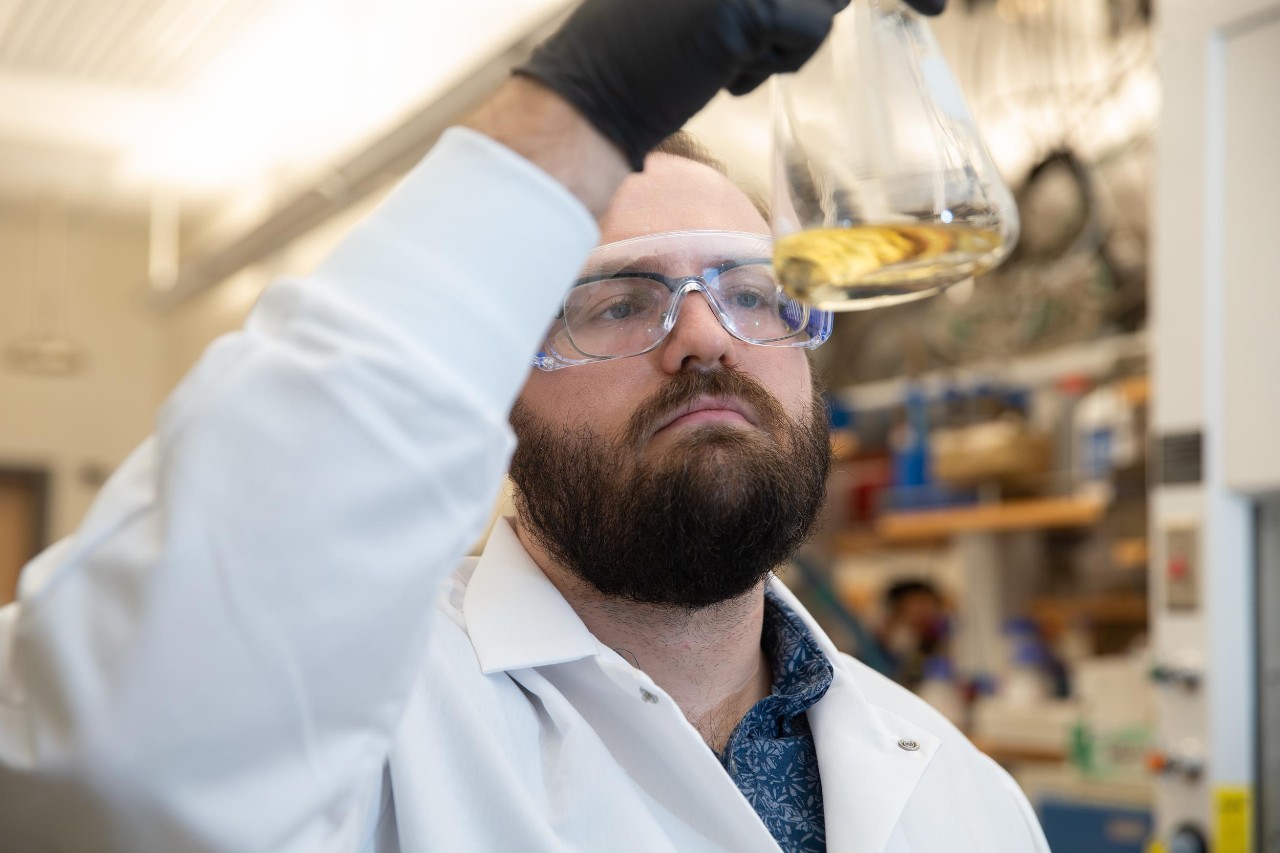
New battery holds promise for green energy
UC chemists develop novel battery designed for storing energy from wind or solar farms
Jimmy Jiang envisions a future where every house is powered by renewable energy stored in batteries — perhaps even those he and his students are designing today.
In his chemistry lab, Jiang and his students at the University of Cincinnati have created a new battery that could have profound implications for the large-scale energy storage needed by wind and solar farms.
Innovations such as UC’s will have profound effects on green energy, Jiang said. Batteries store renewable energy for when it’s needed, not just when it’s produced. This is crucial for getting the most out of wind and solar power, he said.
“Energy generation and energy consumption is always mismatched,” he said. “That’s why it’s important to have a device that can store that energy temporarily and release it when it’s needed.”
They described their novel design in the journal Nature Communications.

Visiting Professor Soumalya Sinha works with chemicals through a protective hood in a chemistry lab. Photo/Andrew Higley/UC Marketing + Brand
Traditional car batteries contain a mix of sulfuric acid and water. And while they are inexpensive and made from readily available materials, they have severe drawbacks for industrial or large-scale use. They have a very low energy density, which isn’t useful for storing megawatts of power needed to power a city.
And they have a low threshold for electrochemical stability. Jiang said that means they can blow up.
“Water has a voltage limit. Once the voltage of an aqueous battery exceeds the stability window of 1.5 volts, the water can decompose or be split into hydrogen and oxygen, which is explosive,” he said.
There is a lot of intense research going into pushing the boundaries of battery performance.
Jimmy Jiang, Associate Professor of Chemistry
But Jiang and his students have developed a battery without water that can generate nearly 4 volts of power. Jiang’s novel design does so without a membrane-separator, which are among the priciest parts of these kinds of batteries, he said.
“Membranes are super expensive,” said Jiang, an associate professor in UC's College of Arts and Sciences. “We developed a new type of energy storage material that improves performance at a lower cost.”
Likewise, membranes are inefficient, he said.
“They can’t separate the positive and negative sides completely, so there is always crossover,” he said.

UC doctoral students Xiao Wang, left, and Rabin Siwakoti work together in a chemistry lab. Photo/Andrew Higley/UC Marketing + Brand
The group has submitted provisional patent applications, he said.
“There is still a long way to go,” Jiang said.
But he said we are hurtling toward a battery revolution in the next 20 years.
“I am confident about that. There is a lot of intense research going into pushing the boundaries of battery performance,” he said.
His students are equally enthusiastic. Doctoral student and study co-author Rabin Siwakoti said the battery offers higher energy density.
“So even a small battery can give you more energy,” he said.
“We’ve managed to eliminate the membrane in a battery, which is a huge component of upfront costs. It’s as much as 30% of the cost of the battery,” co-author and doctoral student Jack McGrath said.
Co-author Soumalya Sinha, a visiting professor at UC, said countries are racing to develop cheaper, more efficient batteries.
“This design significantly decreases material costs,” he said. “We’re trying to achieve the same performance at a cheaper cost.”
Other contributors include lead author and UC postdoctoral researcher Rajeev Gautam, doctoral student Xiao Wang and UC doctoral graduate Amir Lashgari.
Featured image at top: UC College of Arts and Sciences doctoral student Jack McGrath holds up a beaker of fluid in a chemistry lab. Photo/Andrew Higley/UC Marketing + Brand

UC Associate Professor Jimmy Jiang and his students are developing more efficient batteries in his chemistry lab. Photo/Andrew Higley/UC Marketing + Brand
Impact Lives Here
The University of Cincinnati is leading public urban universities into a new era of innovation and impact. Our faculty, staff and students are saving lives, changing outcomes and bending the future in our city's direction. Next Lives Here.
Related Stories
UC launches Bearcat Affordability Grant
January 7, 2026
The University of Cincinnati is making college more attainable for students across Ohio with the creation of the Bearcat Affordability Grant. The new grant will provide a pathway to tuition-free college for students of families who make less than $75,000 per year. Beginning in fall 2026, the Bearcat Affordability Grant will cover the remaining cost of tuition for Ohio residents who are Pell eligible.
How aerospace is turning to trustworthy AI
January 6, 2026
UC College of Engineering and Applied Science graduate Lynn Pickering talks to the Ohio Federal Research Network about her research into artificial intelligence and the future of AI in aerospace engineering.
What's behind the mysterious rise of migraines?
January 5, 2026
Weather patterns such as extreme heat and storm conditions have been linked to migraine attacks, and research shows those environmental conditions are becoming more common. As National Geographic recently reported, one of the leading theories behind this mysterious rise is that climate change may be playing a role.
